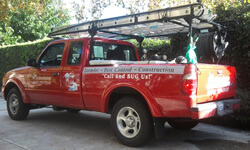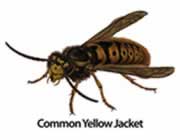Bees, Wasps and Hornets
Bees and Wasps are beneficial insects, although they are generally considered to be pests because of their ability to sting. Wasps, in particular, can become a problem in autumn when they may disrupt many outdoor activities. People often mistakenly call all stinging insects “bees”. While both social wasps and bees live in colonies ruled by queens and maintained by workers, they look and behave differently. It is important to distinguish between these insects because different methods may be necessary to control them if they become a nuisance.
Identification
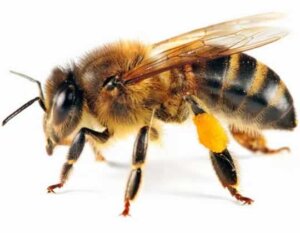
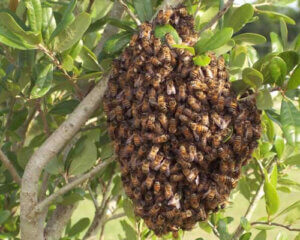 Bees are robust-bodied and very hairy compared with wasps. Their hind legs are flattened for collecting and transporting pollen. Bees are important pollinators. Honey bees are responsible for more than 80% of the pollination required by most fruits, legumes, and vegetable seed plants as well as many ornamentals that are grown in our landscapes.
Bees are robust-bodied and very hairy compared with wasps. Their hind legs are flattened for collecting and transporting pollen. Bees are important pollinators. Honey bees are responsible for more than 80% of the pollination required by most fruits, legumes, and vegetable seed plants as well as many ornamentals that are grown in our landscapes.
Swarming is the natural method bees use to create new colonies. Each swarm contains several thousand worker bees, a queen, and several hundred drones. When the hive, especially the brood nest area, becomes crowded, the bees build swarm cells (new queen cells) and the old queen leaves with a swarm. The swarming bees cluster at a nearby site. They then seek out a new nest location to start a a new hive.
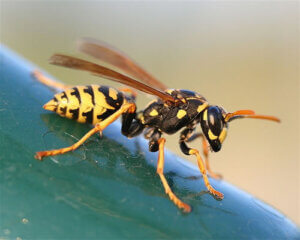
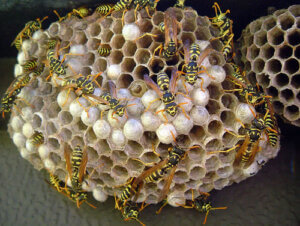 Paper Wasps are about 3/4″ to 1″ inch long with slender, narrow-waist bodies. Their wings are smoky black and they fold lengthwise when at rest. Body coloration varies between brown, red, and yellow. Paper wasps are semi-social insects, colonies consist of three castes: workers, queens and males.
Paper Wasps are about 3/4″ to 1″ inch long with slender, narrow-waist bodies. Their wings are smoky black and they fold lengthwise when at rest. Body coloration varies between brown, red, and yellow. Paper wasps are semi-social insects, colonies consist of three castes: workers, queens and males.
In spring-time fertilized queens select a nesting site and begin to build a nest. Nests are built from wood fiber that is chewed and formed into a single paper-like comb. Nests are oriented downward and are suspended by a single filament. They are commonly found around the home underneath eaves.
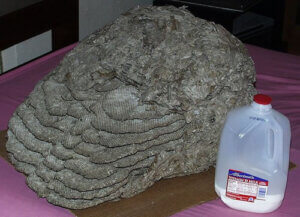

Life Cycle
Bumble bees and wasps have annual colonies that last for only one year. The colony dies in the fall with only the queen surviving the winter.
Honey Bees are perennial insects with colonies surviving more than one year.
Management
Nest Control
Wasp nests that are visible but are not near your home or areas of human activity do not need to be treated. If they are not disturbed, the wasps won’t bother you.
Nests that are near human activity can pose a potential problem. If there is a concern about stings, you should eradicate the nest.
The first step in wasp or bee control is to correctly identify the insect and locate its nesting site. FatCat Exterminators is an experienced pest control service, and provides wasp and bee control services.
Should you want to attempt controlling them yourself, please consider the following:
- Honeybees may be observed on your property without the presence of a nest. This is termed a “swarm.” Swarming usually occurs in late spring and early summer and begins in the warmer hours of the day. Swarms should be left alone due to the fact that they may move on and nest in another area. If the swarm decides to nest on your property, professional help is needed.
- The nests of Yellow jackets and Hornets should always be approached with caution, preferably at night when most of the workers are present but reluctant to fly.
- If you must approach these nests during daytime, a quick knockdown aerosol can be used to keep the bees/wasps at bay, while you treat the nest.
- Sometimes, nests occur in voids such as vents, attics, crawlspaces or hollow walls. Destroying nests in these locations can be difficult, often requiring the services of pest management professionals.
- Be mindful that nests may be located several feet away from the point at which the bees/wasps are entering the structure. Entrance holes should never be plugged, even after treatment, because the bees/wasps will look for other ways to get out of the nest and have been known to chew their way into living quarters, endangering persons inside. Also, use extreme caution when performing bee/wasp control from a ladder.
